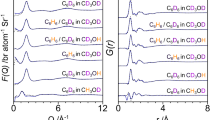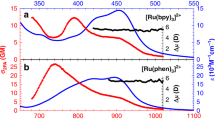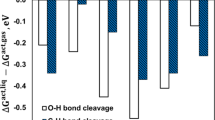Abstract
For solution-phase chemical reactions, the solvent is often considered simply as a medium to allow the reactants to encounter each other by diffusion. Although examples of direct solvent effects on molecular solutes exist, such as the compression of solute bonding electrons due to Pauli repulsion interactions, the solvent is not usually considered a part of the chemical species of interest. We show, using quantum simulations of Na2, that when there are local specific interactions between a solute and solvent that are energetically on the same order as a hydrogen bond, the solvent controls not only the bond dynamics but also the chemical identity of the solute. In tetrahydrofuran, dative bonding interactions between the solvent and Na atoms lead to unique coordination states that must cross a free energy barrier of ~8 kBT—undergoing a chemical reaction—to interconvert. Each coordination state has its own dynamics and spectroscopic signatures, highlighting the importance of considering the solvent in the identity of condensed-phase chemical systems.
This is a preview of subscription content, access via your institution
Access options
Access Nature and 54 other Nature Portfolio journals
Get Nature+, our best-value online-access subscription
$29.99 / 30 days
cancel any time
Subscribe to this journal
Receive 12 print issues and online access
$259.00 per year
only $21.58 per issue
Buy this article
- Purchase on Springer Link
- Instant access to full article PDF
Prices may be subject to local taxes which are calculated during checkout





Similar content being viewed by others
References
Young, R. M. & Neumark, D. M. Dynamics of solvated electrons in clusters. Chem. Rev. 112, 5553–5577 (2012).
Blandamer, M. J. & Fox, M. F. Theory and applications of charge-transfer to solvent spectra. Chem. Rev. 70, 59–93 (1970).
Marcus, R. A. On the theory of oxidation–reduction reactions involving electron transfer. 1. J. Chem. Phys. 24, 966–978 (1956).
Marcus, R. A. & Sutin, N. Electron transfers in chemistry and biology. Acta Biochim. Biophys. 811, 265–322 (1985).
Barthel, E. R., Martini, I. B. & Schwartz, B. J. How does the solvent control electron transfer? Experimental and theoretical studies of the simplest charge transfer reaction. J. Phys. Chem. B. 105, 12230–12241 (2001).
Suppan, P. Solvatochromic shifts: the influence of the medium on the energy of electronic states. J. Photochem. Photobiol. 50, 293–330 (1990).
Bagchi, B. Isomerization dynamics in solution. Int. Rev. Phys. Chem. 6, 1–33 (1987).
Glover, W. J., Larsen, R. E. & Schwartz, B. J. How does a solvent affect chemical bonds? Mixed quantum/classical simulations with a full CI treatment of the bonding electrons. J. Phys. Chem. Lett. 1, 165–169 (2010).
Glover, W. J., Larsen, R. E. & Schwartz, B. J. First principles multi-electron mixed quantum/classical simulations in the condensed phase. I. An efficient Fourier-grid method for solving the many-electron problem. J. Chem. Phys. 132, 144101 (2010).
Glover, W. J., Larsen, R. E. & Schwartz, B. J. The roles of electronic exchange and correlation in charge-transfer-to-solvent dynamics: many-electron non-adiabatic mixed quantum/classical simulations of photoexcited sodium anions in the condensed phase. J. Chem. Phys. 129, 1–20 (2008).
Smallwood, C. J., Mejia, C. N., Glover, W. R., Larsen, R. E. & Schwartz, B. J. A computationally-efficient exact pseudopotential method. 2. Application to the molecular pseudopotential of an excess electron interacting with tetrahydrofuran (THF). J. Chem. Phys. 125, 9681–9691 (2006).
Glover, W. J., Larsen, R. E. & Schwartz, B. J. First principles multi-electron mixed quantum/classical simulations in the condensed phase. II. The charge-transfer-to-solvent states of sodium anions in liquid tetrahydrofuran. J. Chem. Phys. 132, 144102 (2010).
Glover, W. J., Larsen, R. E. & Schwartz, B. J. The nature of sodium atoms/(Na+–e−) contact pairs in liquid tetrahydrofuran. J. Phys. Chem. B 114, 11535–11543 (2010).
Gervais, B. et al. Simple DFT model of clusters embedded in rare gas matrix: trapping sites and spectroscopic properties of Na embedded in Ar. J. Chem. Phys. 121, 8466–8480 (2004).
Szaz, L. Pseudopotential Theory of Atoms and Molecules. (Wiley: New York, 1985).
Liu, Z., Carter, L. E. & Carter, E. A. Full configuration interaction molecular dynamics of Na2 and Na3. J. Phys. Chem. 99, 4355–4359 (1995).
Lennard-Jones, J. E. The electronic structure of some diatomic molecules. Trans. Faraday Soc. 25, 668–686 (1929).
Coulson, C. A. Representation of simple molecules by molecular orbitals. Q. Rev. Chem. Soc. 1, 144–178 (1947).
Glover, W. J., Larsen, R. E. & Schwartz, B. J. Simulating the formation of sodium:electron tight-contact pairs: watching the solvation of atoms in liquids one molecule at a time. J. Phys. Chem. A 115, 5887–5894 (2011).
Bragg, A. E., Glover, W. J. & Schwartz, B. J. Watching the solvation of atoms in liquids one solvent molecule at a time. Phys. Rev. Lett. 104, 233005 (2010).
Cavanagh, M. C., Larsen, R. E. & Schwartz, B. J. Watching Na atoms solvate into Na+–e− contact pairs: untangling the ultrafast charge-transfer-to-solvent dynamics of Na− in tetrahydrofuran (THF). J. Phys. Chem. 111, 5144–5157 (2007).
Chandrasekhar, J. & Jorgensen, W. L. The nature of dilute-solutions of sodium-ion in water, methanol, and tetrahydrofuran. J. Chem. Phys. 77, 5080–5089 (1982).
Mardirossian, N. & Head-Gordon, M. ωB97M-V: a combinatorially optimized, range-separated hybrid, meta-GGA density functional with VV10 nonlocal correlation. J. Chem. Phys. 144, 214110–214200 (2016).
Bedard-Hearn, M. J., Larsen, R. E. & Schwartz, B. J. Understanding nonequilibrium solvent motions through molecular projections: computer simulations of solvation dynamics in liquid tetrahydrofuran (THF). J. Phys. Chem. B 107, 14464–14475 (2003).
Kornath, A., Zoermer, A. & Ludwig, R. Formation of the magic cluster Na8 in noble gas matrixes. Inorg. Chem. 41, 6206–6210 (2002).
Kornath, A., Ludwig, R. & Zoermer, A. Small potassium clusters. Angew. Chem. Int. Ed. 37, 1575–1577 (1998).
Ozin, G. A. & Huber, H. The matrix optical spectra of sodium molecules containing from two to four atoms. Inorg. Chem. 18, 1402–1406 (1979).
Welker, T. & Martin, T. P. Optical-absorption of matrix isolated Li, Na, and Ag clusters and microcrystals. J. Chem. Phys. 70, 5683–5691 (1979).
Hofmann, M., Leutwyler, S. & Schulze, W. Matrix isolation-aggregation of sodium atoms and molecules formed in a supersonic nozzle bean. Chem. Phys. 40, 145–152 (1979).
Froben, F. W. & Schulze, W. Raman measurements of matrix-isolated small metal-clusters. Phys. Chem. Chem. Phys. 88, 312–314 (1984).
Kornath, A., Zoermer, A. & Ludwig, R. Raman spectroscopy investigation of matrix-isolated rubidium and cesium molecules: Rb2, Rb3, Cs2, and Cs3. Inorg. Chem. 38, 4696–4699 (1999).
Scott, D. R. & Allison, J. B. Solvent glasses for low temperature spectroscopic studies. J. Phys. Chem. 66, 561–562 (1962).
Kato, H., Matsui, T. & Noda, C. Na2 (A 1∑+ u → X 1∑+ g) fluorescence accompanied by a continuous spectrum. J. Chem. Phys. 76, 5678–5683 (1982).
Verma, K. K., Bahns, J. T., Rajeiriza, A. R., Stwalley, W. C. & Zemke, W. T. First observation of bound-continuum transitions in the laser-induced A 1∑+ u → X 1∑+ g fluorescence of Na2. J. Chem. Phys. 78, 3599–3613 (1983).
Barrow, R. F., Verges, J., Effantin, C., Hussein, K. & D’incan, J. Long-range potentials for the X 1∑+ g and (1)1 ∑g states and the dissociation energy of Na2. Chem. Phys. Lett. 104, 179–183 (1984).
Babaky, O. & Hussein, K. The ground state X 1∑+ g of Na2. Can. J. Phys. 67, 912–918 (1989).
Phillips, J. C. & Kleinman, L. New method for calculating wave functions in crystals and molecules. Phys. Rev. 116, 287–294 (1959).
Smallwood, C. J., Larsen, R. E., Glover, W. G. & Schwartz, B. J. A computationally-efficient exact pseudopotential method. I. Analytic reformulation of the Philips–Kleinman theory. J. Chem. Phys. 125, 074102 (2006).
Larsen, R. E., Glover, W. J. & Schwartz, B. J. Does the hydrated electron occupy a cavity? Science 329, 65–69 (2010).
Allen, M. P. & Tildesley, D. J. Computer Simulation of Liquids (Oxford Univ. Press, London, 1992).
Steinhauser, O. Reaction field simulation of water. Mol. Phys. 45, 335–348 (1982).
Smit, B. Phase-diagrams of Lennard-Jones fluids. J. Chem. Phys. 96, 8639–4860 (1992).
Acknowledgements
Early portions of this work were supported by the National Science Foundation (grant CHE-1565434). Beginning in September 2017, this work was supported by the US Department of Energy Condensed Phase and Interfacial Molecular Science programme (grant 0000228903). The authors acknowledge the Institute for Digital Research and Education (IDRE) at UCLA for use of the hoffman2 computing cluster, B. Taggart for assistance setting up the simulations, and W. Glover and C.-C. Zhou for discussions.
Author information
Authors and Affiliations
Contributions
The work described in this text was completed by D.R.W. under the supervision of B.J.S.
Corresponding authors
Ethics declarations
Competing interests
The authors declare no competing interests.
Supplementary information
Supplementary Information
Supplementary Methods and Supplementary Analysis
Rights and permissions
About this article
Cite this article
Widmer, D.R., Schwartz, B.J. Solvents can control solute molecular identity. Nature Chem 10, 910–916 (2018). https://doi.org/10.1038/s41557-018-0066-z
Received:
Accepted:
Published:
Issue Date:
DOI: https://doi.org/10.1038/s41557-018-0066-z
This article is cited by
-
Accurate and efficient molecular dynamics based on machine learning and non von Neumann architecture
npj Computational Materials (2022)
-
Recovering the electrochemical window by forming a localized solvation nanostructure in ionic liquids with trace water
Science China Chemistry (2022)



